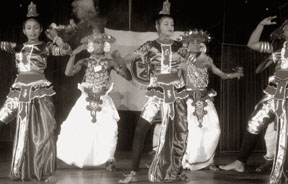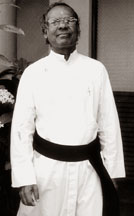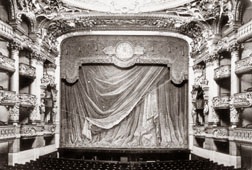|
DAILY NEWS ONLINE |
|
|
|
OTHER EDITIONS |
|
|
|
|
|
|
|
|
|
OTHER LINKS |
|
|
|
|
|
|
  |
|
Emotional tempest through Baroque music
|
|
|
The Centre for Performing Arts (CPA) is making elaborate arrangements to hold a function on Saturday (Dec. 3) at the Colombo CPA Centre, Milagiriya Avenue, Bambalapitiya, Colombo-4 in connection with the completion of the CPA's treasured 40 years and also to celebrate the CPA founder Professor Rev. N. M. Saveri's 66th birthday which falls on 3rd December, 2005.
In fact, the CPA which was established in 1965 by Prof. Rev. N. M. Saveri to promote Art and Culture to bring about peace and communal harmony among all communities has completed 40 years of tremendous service.
For this purpose a series of cultural events were held in Colombo, Jaffna and Kandy in which more than 250 artistes from 20 regional centres both Sinhala and Tamil participated.
|
|
Besides this, the CPA also held a women's convention in Bandarawela Town Council Hall which was organised by Mrs. A. Jenova who is the co-ordinator and in charge of the women's section of the CPA. The 40th anniversary celebration of CPA which was held in Kandy at the Hindu Cultural Centre Hall on October 28 and 29, 2005, artistes from 10 regional centres namely Anuradhapura, Polonnaruwa, Avissawella, Moneragala, Hambantota, Galle, Ratnapura, Matara and Kandy participated. Even Tamil co-ordinators took part in these celebrations.
Several Sinhala artistes from all these 10 centres presented a series of cultural events like dances, songs and dramas depicting evils in society, untold suffering and hardships due to two decades of war and also tsunami disaster.
Professor Rev. N. M. Saveri who is the founder of the Centre for Performing Arts (Thirumarai Kala Mandram) is an individual with superior intelligence and indomitable courage who established this Centre in 1965 with the main aim of promoting peace, justice and equality among all communities through art and culture particularly dramas pertaining to peace.
Though the Centre for Performing Arts was started in Jaffna, it was expanded to the other parts of Sri Lanka since 1990, with the aim of creating an atmosphere of peace and harmony among Sinhala, Tamil and Muslim communities. For this purpose Prof. N. M. Saveri started organising several inter-regional and inter-cultural seminars, stage performances in Colombo and Southern part of Sri Lanka.
Paris Opera Ballet and the Kirov: two leading ballet companies
Sited in the opposite sides of the hemisphere, two of the leading ballet companies in the world are the Paris Opera Ballet and the Kirov among others. Paris is the post-romantic years, was very much aware of the poor state of the National Ballet and was determined to persue almost every possible way to improve the position.
|
|
By 1913 the then Opera director, Jacques Rouch tried valiantly to get Nijinsky as the Opera's main dancer. It was during this time that Nijinsky had married and had been blacklisted by Diaghilev.
Nijinsky declined Rouche's offer for various reasons. Several years later, Rouche in a bid to get some sparkle to the Opera's life, engaged Fokine and revived many ballets that were in the repertory.
Paris Opera Ballet may have been rapidly assumed its old state and improved in the methods of teaching. A number of eminent Russian dancers have taught in Paris over the years. Fortunately for Paris Ballet, Rouche was not a man who easily got rattled in the face of adversity.
He strived continuously to improve the ballet company. People again began to take interest in the Paris Opera Ballet. He hired Lifar who for the beginning failed to make an impression but his style was derivative. It was the right age for change, the age of Massine and not of Saint Leon. Lifar provided the Opera with new life and vitality. There was hope for the future and excitement and the urgency to remember the days of Diaghilev. After the magnificent week done by Lifar, Yvette Chauvere from the Opera's school emerged and renewed more hope. As a dancer she compared with the best of Russian dancers and was of a calibre that France had never seen before.
Lifar revealed her unique artistry in his new version of Istar in 1942. She soon attained high status overnight and was also nurtured by Boris Knisev's work in correcting her Milanese manner of training. It was more in line with the Russian school.
However, Chauvire could not tolerate the insensitive conditions at the Paris Opera to take ballet seriously and in the company of equally dissatisfied Renee Jeanmaire, Colette Marchand and Roland Petit, finally left the company.
The fact that an individual in Paris in the 1940s had to break off from the crippling State organisation to give her expressions in her true artistic talent, was a stumbling block for the dancer to emerge out.
Not content with the artists and composers of this quality, Petit took it upon himself to assemble some of the best dancers of the day which included Jeanmaire, Charrat, Merchand, Irene Skorik, Irene Lidova, Ethery Pagave, Nina Vyroubova, Jean Bibilee, etc. and along with the Petit danced himself. Although he was technically a perfect dancer, he was also an equally good choreographer whose work was beyond choreographic thought in France of the day.
The company was important in that it served French Ballet at a time when it was more to obtain a new look. Petit was not happy under these circumstances as he had yet to repeat the success he enjoyed initially. He remains even today as a doyen of French choreographers. He had produced world renowned dancers from time to time for the company.
Some of Europe's best dances have been seen with the Paris Opera Ballet though France like Italy had produced fine dancers who were confined to their countries. They hardly made an international name for themselves.
A major development took place in French ballet in 1962 with the formation of the Ballet Theatre Contemporian which became the first French national company to devote its resources to the making of new choreography. After the establishment of the Academic Royale in 1661 which was the beginning of the French Opera Ballet centuries later, another such academy the Leningrad Academy established in 1785 was the forerunner to the Kirov. Amidst problems and other obstacles, both companies rose to be the most magnificent training grounds for ballet.
The quality of lyricism and grace are still there though the Kirov has entered the technical age with a lively step. This offers the super dancers to be powered by nuclear energy. There may be different opinions and scenery but the choreographic contentions are two different opinions for the home-grown ballerina. By comparison the fully blown Kirov stood firmly ahead of the Western ballet which was still young and on the threshold of vigorous adolescence.
At the Kirov life goes on unhampered with the shackle of time and together with absolute unity to maintain discipline, integrity, beauty and the cardinal principles are never lost. There is no apparent staleness or boredom but the vigour, strength and the love for this wonderful art are kept in a state of meticulous care.
They are polished, preserved with scrupulous repair and danced with every fibre of the dancers' spirit. The Kirov is perhaps too involved in the refractory but Sereyev's ballet, brilliantly contrived the production of highly polished excellence. The Festival of the White Nights gave numerous galas.
Sereyev's production of Hamlet in the early years was a spectacular tribute to Shakespeare. It still ranks as an epic ballet held in the Kirov repertoire. While he choreographed Hamlet, he used the hauntingly beautiful music of Tchaikovsky that made the ballet memorable.
Once Sereyev said that the most difficult thing in ballet is to find form of movement which would suit the internal spirit of the image. The dance material should find its development in accordance with the growth of the dramatic image and in strict alliance with the musical pattern.
Sereyev carried this pattern and precepts in a masterly way in Hamlet. He made this the life-blood of the Kirov. No one impacted it the way he did. Because of its great role for the ballerina, Giselle the most Romantic ballet of all, was called the Hamlet of ballet.
It is a continuous repertoire with many interpretations at the Kirov and for many years the role of Giselle and Albrecht have been danced by Irina Kolpakova and Yuri Soloviev. No more lyrical dancing of these roles could have ever been given again. Tragically, Soloviev passed away leaving behind Kolpokova as the shining ballerina of the classical repertoire. This was Kirov's speciality.
For most part of the atmosphere of Russian classical ballet at the Kirov is potent and heads with the music of the Russian Masters whose sweetness and sensuous cadence seduced the senses like a drug. Kirov's absolute effortlessness reflect the traditional glory of the school.
Young dancers continue the precedence left by their icons and experience the excitement and thrill of their virile leaps and such notable dancers like Anatole Pavlovsky or the pristine grace of Anna Pavlova or Galina Ulanova. Their spirit take over the young dancers to muscle and sinew the reals of mystical uncharted forces. The young can feel the marvel and the exhilaration of their spirit. The Kirov creates that spirit in the young.
One cannot forget the contribution made by Agripina Vaganova whose celebration took place in 1979. Vaganova who danced at the Maryinksy in 1897 in the corp de ballet, became the authority in Russian classical dancing and later became the artistic director of the Kirov and was the person who made the greatest contribution to Russia as no other person ever did and Vaganova Choreographic Academy is a tribute to her, especially from the Kirov.
An evening with Jean-Jacques Milteau
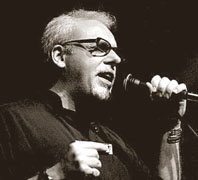 It was a cheerful gathering of diplomats, literati and the
enthusiastic music lover at the Lionel Wendt Art Gallery in a quite and
fashionable quarter of the Colombo. Though Sri Lankans are familiar with
Anglo-American musicians and composers of different hues who often visit
the city with much publicity, this was a very rare occasion of a French
harmonica player's live-in-concert in Colombo.
It was a cheerful gathering of diplomats, literati and the
enthusiastic music lover at the Lionel Wendt Art Gallery in a quite and
fashionable quarter of the Colombo. Though Sri Lankans are familiar with
Anglo-American musicians and composers of different hues who often visit
the city with much publicity, this was a very rare occasion of a French
harmonica player's live-in-concert in Colombo.
He was none other than world-renowned harmonica player, Jean-Jacques Milteau who for the first time performed in Colombo on the invitation of the Alliance Francaise de Colombo as a part of its 50 year anniversary celebrations.
Born in Paris in 1950, blues harmonica player Jean-Jacques Milteau first discovered the harmonica in mid 60s while listening to rock albums by artists such as Bob Dylan and Rolling Stones. A heavy interest in the blues ensued and later on, a trip to America, Milteau became enthralled with the traditional blues of artists such as Little Walter, Charlie McCoy, and others.
In the late 70s Milteau decided to devote his entire career to perform music and began making various gigs around Paris, performed with such high profile artists as Charles Aznavour, Jean-Jacques Goldman, Yves Montand. It was not until 1989 though that Milteau released his solo debut, Blues Harp, Milteau started to add writings to his resume, including various harmonica methods books and released his share of albums in Europe and toured extensively. Milteau released the Tennessee-recorded Memphis in 2003.
Milteau is a harmonica player who performed in quite unexpected places from North Poles Circle (Saint Pierre Miquelon) to South Africa, from Switzerland to Cuba. His music is evocative and has a profound visual effect so much so that it is known as " Road movie on a virtual screen".
The concert is well received in Colombo and was an unforgettable experience for Sri Lankan music lovers.
Mathura Strings on Dec. 3
Isaack Kulendran's Mathura Strings will be having their programme of 'ushering in Christmas Breeze' this year too at the C.S.I. Church, Frances Road, Wellawatte on December 3 at 6.30 p.m.
|
|
Since most of the players are his pupils, he has arranged a programme interspersed with solos by them, to encourage them and also for them to gain more experience. Little Quirin Schwendtke will sing the familiar children's favourite 'Away in a manger 'while prize winner Ruth Anketell will follow it up with 'Thou dids't leave Thy throne'.
Not to be outdone, there are the very promising young violin pupils - Rebekah Peiris and Sanjeewa Weerasinghe with violin solos to suit their standards. Rosana Kulendran and Premila Perinpanayagam are accomplished violinists, in their own way, and will be contributing their share, while the latter will be accompanying them on the piano as well.
Ramesh P. Ganohiriti will be the star performer with his message 'Celebrating Christmas' which is a repeat from last year, owing to its high acclaim. Nilanthi Weerakoon will add variety to the programme with a flute solo.
This is a rare blend of worship service and a concert programme, in keeping with Psalms 150 verses 1 to 4. All music lovers and critics are cordially invited.
|
|

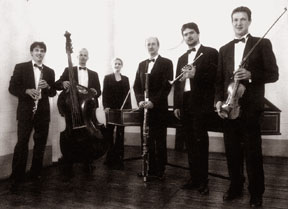 The images drift through my mind as I sit listening to Baroque Music,
at the Auditorium of the Colombo International School on 27th November
2005.
The images drift through my mind as I sit listening to Baroque Music,
at the Auditorium of the Colombo International School on 27th November
2005. 